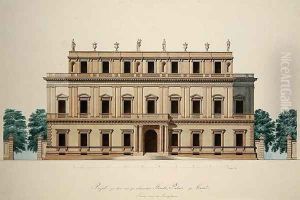Julius Eugen Ruhl Paintings
Julius Eugen Ruhl was a German sculptor born on January 8, 1878, in Kassel, Germany. Ruhl was part of a generation of artists that came of age during the late 19th and early 20th centuries, a period characterized by significant changes in art, with movements such as Impressionism, Expressionism, and the beginnings of Modernism emerging in Europe.
Ruhl studied at the Kunstakademie Kassel (Kassel Academy of Fine Arts) and later furthered his education in other parts of Germany, including Munich, which was an important center for art and culture at the time. His work largely consisted of sculptures and monuments that reflected the neoclassical tradition, combined with a sense of naturalism that was becoming more prevalent in the art of this period.
Although not as widely recognized as some of his contemporaries, Ruhl's craftsmanship and attention to detail were evident in his figurative works. He tended to focus on allegorical themes, often incorporating elements of mythology and history into his sculptures. The beginning of the 20th century was a time of great innovation in sculpture, with artists like Auguste Rodin influencing the direction of the medium. Ruhl's work, while not avant-garde, was part of the rich tapestry of artistic production during this transformative time.
Tragically, Julius Eugen Ruhl's life and career were cut short by the outbreak of World War I. He served in the German military during the war and died in battle in 1914, at the age of 36. As a result, Ruhl did not live to see the full impact of the war on the world and the arts, nor the further evolution of sculpture throughout the 20th century. Despite his premature death, Ruhl's sculptures remain as a testament to his skill and the artistic currents of his time.
